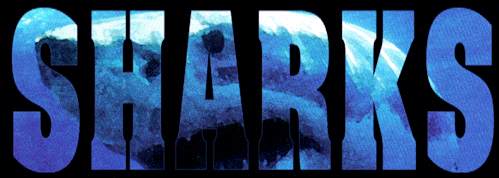

This page gives a minor introduction to sharks. Sharks are neither friends or foes. They are merely creatures trying to survive. But because of their immense success they are often viewed as dangerous predators and man-eaters. Hopefully this page will clarify some of these misconceptions, answer a few questions, and shed some light on these great creatures. This page also includes some aspects of shark biology, taxonomy, current research, and studies.

Little is understood about the early evolution of prehistoric sharks. The shark's skeletons is made of cartilage, therefore a fossilized shark is a rare find. But the teeth are partially composed of calcium phosphate and can easily fossilize. Fossilized teeth have been dated as far back as 385 millions years (middle of the Devonian period). The most famous of these prehistoric sharks is Carcharodon megalodon. It's notoriety was earned by the movie JAWS. The shark is suppose to be 12 to 15 meters in lenght and weighs in at 20 tons (measurements are based on the size of the teeth found). This is double the size of the present day great white. The megadolon was thought to have existed in the Miocene period (about 10 to 25 million years ago). Contrary to popular belief the megadolon is not directly related to the great white shark of Jaws fame. The evolution of the white shark branches into two lines. The first line is classified by coursely serrated teeth (present day whites are from this line). The other line has finely serrated teeth (i.e. the megadolon). The sharks from this lineage have been know to reach gargantuin size. For more information on prehistoric sharks try these sites.
During the Paleozoic period the majority of the sharks can be classified into two groups; the xenacanths and the hybodonts. The xenacanths were confined to freshwater but are noted for their ability to persevere. They have existed for 230 million years. The hybodonts lived in both fresh and salt water environments. Fossil records show that they existed about 320 million years ago. Hydobonts became extinct along the same period as the dinosaurs. At the present time sharks are considered to be living fossils but recent studies show that they are highly specialized and evolved creatures.
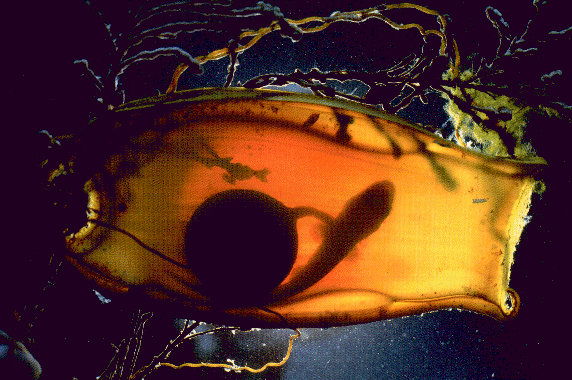 One of the most important features of sharks are their teeth. Their teeth are largely responsible for their of survival and success as a predator. All sharks have rows of teeth. Therefore if the front is broken off it is replaced by the row behind it. But some sharks are gill rakers and just feed on plankton. They have reduced teeth and when feeding merely swims around with it mouth open. One of the largest fish,the basking shark, does this. The largest fish, the whale shark, feeds in the same manner, but supplements its diet with small fish. The horn shark is also has rows of teeth but they are modified for crushing. Another tooth type are the sharp serrated variety that can easily grasp and rip apart prey (usually found in the order Carcharhiniformes) .
One of the most important features of sharks are their teeth. Their teeth are largely responsible for their of survival and success as a predator. All sharks have rows of teeth. Therefore if the front is broken off it is replaced by the row behind it. But some sharks are gill rakers and just feed on plankton. They have reduced teeth and when feeding merely swims around with it mouth open. One of the largest fish,the basking shark, does this. The largest fish, the whale shark, feeds in the same manner, but supplements its diet with small fish. The horn shark is also has rows of teeth but they are modified for crushing. Another tooth type are the sharp serrated variety that can easily grasp and rip apart prey (usually found in the order Carcharhiniformes) .
One amazing aspect of the sharks physiology are their keen senses. Their most remarkable trait is their ability to detect weak electrical voltages through ampullae of Lorenzini. Because of this sharks can easily navigate and can detect nearby prey (all living organisms emit a magnetic field). Their nasal sacks give them a keen sense of smell. The scent of hemoglobin will change the behavior of the shark from kind and cuddly to voracious and vicious.
There are three different kinds of reproduction. One is oviparous which is the laying of eggs - in a matter of months they will hatch (pictured on the left). The second and third are two kinds of vivipares: aplacental and plcental. Aplacental is when the embryo grows in the mother's uterus but lives off of an egg yolk. The embryo is not attached to the mother's uterus. Another type of viviparous reproduction is placental. This is when the embryos are attached to the to the uterus and a "yolk". In this fashion any nutrients that are not provided by the "placenta" are taken directly from the mother. Waste is also passed along (reverse) in this manner. One interesting aspect pf reproduction is intra-uterine cannibalism which occurs towards the end of gestation. The most developed embryo begins to devour its less developed siblings. Usually the gestation period will last from nine to twelve months. Try these links for more information on shark biology:
There is still much to learn about sharks, such as their mating behavior, if there are any territorial defenses, feeding behavior, and response to a variety of stimuli. But since sharks are open ocean fishes, to track and observe them is difficult and expensive.
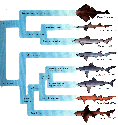 Classification Tree
Classification Tree
Sharks are classsified by the number of fins that they, body type, eyelids, and the positions of their month. Usually the number of dorsal, anal fins will suffice in the classification of sharks. The following will show the classification of sharks down to the order.
Kingdom: Animalia
Phylum: Cordata
Class: Chondrichthyes
Under this class there are eight orders of sharks
Order: Hexanchiformes: the six-gilled shark with only one dorsal fin (i.e. the frilled and cow shark).
Order: Squaliformes: the dogfish shark. Charateristics include: the mouths are underneath and a short snout.
Order Pristiophoriformes: are the sawsharks. Characteristics include: the absence of anal fin. The snout is elongated and sawlike with the mouth located underneath.
Order: Squatiniformes which are the angel-shark. Characteristics are is no anal fin, the body is flattened and the mouth is in front.
Order: Heterodontiformes: the bull sharks, nurse sharks. Most well known characteristics are the different shaped teeth from the front to the back of the mouth. Anal fin and dorsal fin spines are present.
Order:Orectolobiformes:the carpet sharks and the whale shark. This order have anal fins and extended tail lobes.
Order: Lamniformes are the makerel sharks which include the basking shark, the great white and the tresher shark. Characteristics include the mouth being located behind the front of the eyes, and no nictitating eyelid.
Order: Carcharhiniformes are the hammerheads and the requim sharks. Most prominant characteristic is their nictating eyelid that closes over the eye when feeding.
There are about 370 different species of sharks and over 30 families. New find of evolutionary line and characteristics change the taxonomy often.
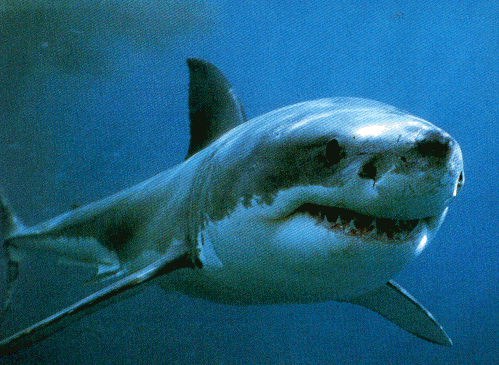
The most frequent shark attack happen in Australian waters. This is due to the large number of seal colonies and rookeries in the area. As popularity of swimming, surfing, and scuba diving grows so does the probability of shark attack. The most sharks that are know to attack are the great whites, the tiger and the bull sharks. Out of these three sharks the bull shaks even though less physically impressive as the great white have been responsible for the majority of shark attacks. The bull shark can live in both fresh and saltwater it is a versitile and oppurtunistic eater. The tiger shark is the most feared in tropic waters. This shark is known to repeatedly attack swimmers and divers. Try these sites for reports on shark attacks
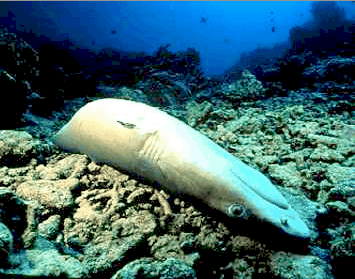 Sharks may be considered a menace to humans, but in reality we are the menace. We inhumanly fin the sharks and throw the shark live back. Without it's fins the sharks can no longer swim or hunt. Instead it will slowly die of starvation. The eatting trend of shark soup and shark meat is causing the sharks population to be overfished. Replacement of sharks is difficult because of their long life cycle. A "typical" requim female is sexually mature at twelve years old. The males start reproducing at eight years of age.
Sharks may be considered a menace to humans, but in reality we are the menace. We inhumanly fin the sharks and throw the shark live back. Without it's fins the sharks can no longer swim or hunt. Instead it will slowly die of starvation. The eatting trend of shark soup and shark meat is causing the sharks population to be overfished. Replacement of sharks is difficult because of their long life cycle. A "typical" requim female is sexually mature at twelve years old. The males start reproducing at eight years of age.
As beaches become popular tourist spots- preventive shark attack measure have been taken. But these measure are quite destructive and contribute to the already depleted shark population. For more information on conservation and the green movement in general try these sites.
For current research being done; try these sites.
If you're intersted in other types of marine life and want a closer view; try these sites from aquariums from around the world.
For futher research on sharks try teleneting to CSULA library or CARL for journal articles and to Melvyl for limited acess to the University of California library system (must fill in the type of terminal). Use gopher for another type of WWW search.
 Login as library
Login as library
 CARL
CARL
 Melvyl
Melvyl
 Gopher
Gopher


The following has been added by the Electronic Desktop Project:
 Contact Us
Contact UsIf you are an educator who is using our NEXTSTEP or virtual applications in the classroom, we would especially like to hear from you. Let us know what you are doing and how it is working out. Continued support for this project will depend on its impact in science education.
If you are an educator who is interested in making use of our NEXTSTEP or virtual applications, please let us know how we can help.
 Return to the Electronic Desktop Project home page
Return to the Electronic Desktop Project home page
![]() Check out the WWW Virtual Application Catalog from the EDP
Check out the WWW Virtual Application Catalog from the EDP
 Check out the NEXTSTEP Application Catalog from the EDP
Check out the NEXTSTEP Application Catalog from the EDP
 Visit the home page for California State University, Los Angeles
Visit the home page for California State University, Los Angeles